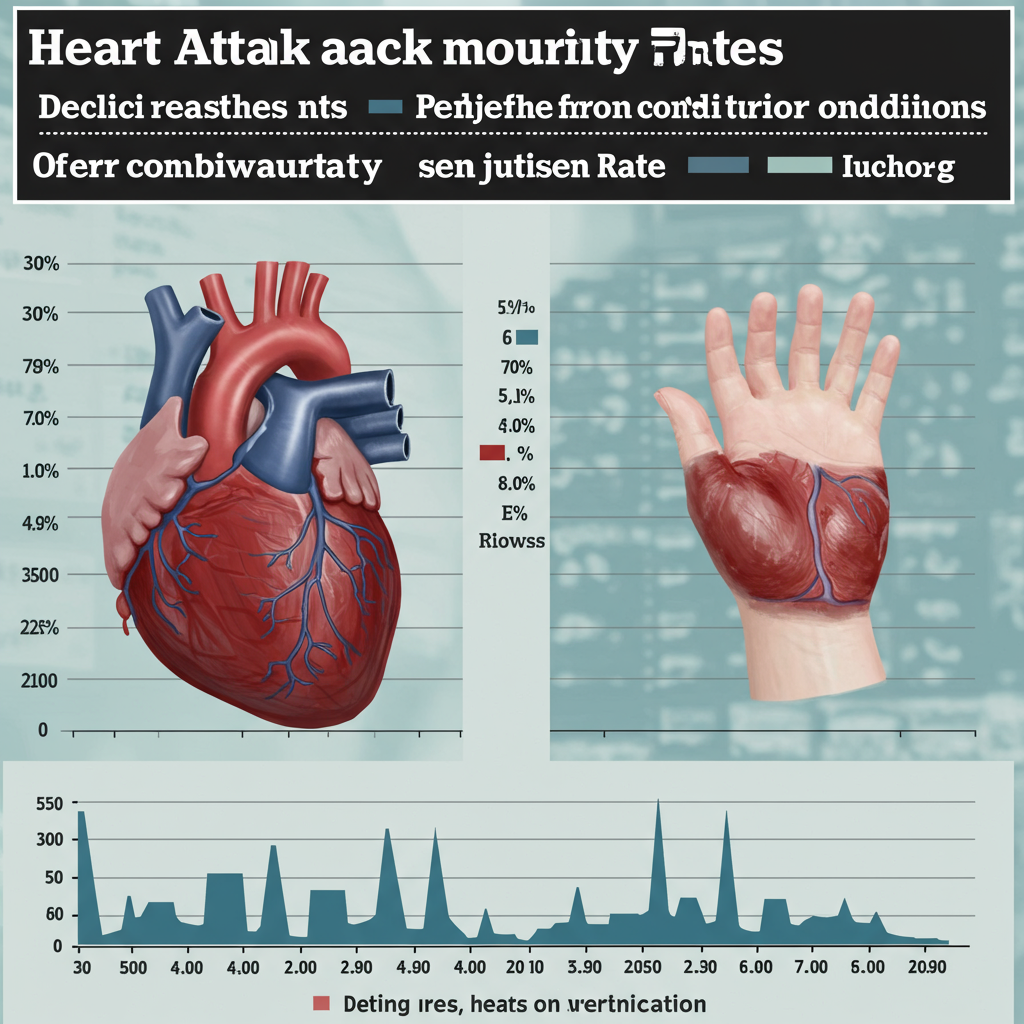Medical science and public health initiatives have achieved remarkable success in combating one of the nation’s leading health threats: fatal heart attacks. Recent analysis reveals a dramatic decline in mortality rates from acute myocardial infarction (heart attack) over the past five decades. However, this encouraging progress is overshadowed by a concerning rise in deaths attributable to other significant cardiovascular conditions, painting a complex picture of heart health in the United States.
The Triumph: A Near 90% Drop in Heart Attack Fatalities
A groundbreaking study published in the Journal of the American Heart Association highlights the impressive strides made in reducing deaths specifically caused by heart attacks. Examining data spanning from 1970 to 2022 for individuals aged 25 and older, researchers found that the age-adjusted death rate from heart attacks plummeted by a staggering 89%. In 1970, over half (54%) of individuals included in the study who died of heart disease succumbed to a heart attack. By 2022, this figure had fallen to just 29%. This success story has also contributed to a significant overall drop in heart disease death rates across the population, which decreased by 66% during the same period.
Breakthroughs Driving the Decline
The dramatic reduction in heart attack deaths didn’t happen by chance. It is primarily attributed to transformative advancements in medical technology and therapeutic strategies developed and refined over the past 50 years.
Technological Innovations
Key to this progress has been the revolution in diagnostic and interventional procedures. Improved cardiac imaging techniques allow for faster, more accurate identification of heart damage. Coronary stenting, a procedure where a small tube is inserted to open blocked arteries, has become a cornerstone of emergency heart attack treatment, restoring blood flow and minimizing damage.
Pharmaceutical Powerhouses
Alongside technological breakthroughs, the development and widespread use of potent medical therapies have played a crucial role. Drugs like aspirin, which helps prevent blood clots, and thrombolytics (clot-busting medications) can rapidly address the blockages that cause heart attacks. These and other pharmacological interventions have significantly improved outcomes for patients experiencing acute cardiac events. According to Dr. Sara King, the study’s first author, this evolution reflects “incredible successes in the way heart attacks and other types of ischemic heart disease are managed.”
The Challenge: Rising Deaths from Other Heart Conditions
Despite the major victory against fatal heart attacks, heart disease tragically remains the leading cause of death in the United States. The study reveals a worrying shift in the landscape of cardiovascular mortality. While fewer people are dying specifically from heart attacks, more are dying from other serious heart conditions, such as heart failure, arrhythmias, and hypertensive heart disease (conditions related to high blood pressure).
Between 1970 and 2022, deaths from this combined group of conditions increased by a substantial 81%. In 1970, these conditions accounted for only 9% of all heart disease deaths. By 2022, they were responsible for a concerning 47% of all heart disease fatalities. This “distribution shift” highlights emerging challenges for the medical community, as noted by Dr. King.
Delving into the Increasing Fatalities
The study provided specific details on the alarming rise in age-adjusted death rates for individual non-heart attack conditions:
Alarming Increase in Arrhythmia Fatalities
Arrhythmias, which involve irregular heartbeats caused by faulty electrical signals in the heart, showed the most dramatic increase. The age-adjusted death rate from arrhythmias surged by an astonishing 450% between 1970 and 2022.
Heart Failure Deaths on the Rise
Heart failure, a chronic condition where the heart cannot effectively pump enough blood to meet the body’s needs, also saw a significant increase in mortality. The age-adjusted death rate for heart failure rose by 146% over the study period.
Hypertensive Heart Disease: A Growing Threat
Deaths related to hypertensive heart disease, conditions caused by persistently high blood pressure damaging the heart, increased significantly as well. The age-adjusted death rate for hypertensive heart disease climbed by 106% between 1970 and 2022.
Understanding the Underlying Factors
The surge in deaths from these other heart conditions points to complex underlying factors. While medical advances are better at saving people during a heart attack, individuals who survive may live longer but potentially develop other chronic heart issues over time. Furthermore, the study’s authors point to the increasing prevalence of major risk factors that contribute to the development and worsening of these conditions.
Impact of Lifestyle Risk Factors
The past five decades have seen a worrying rise in key cardiovascular risk factors within the U.S. population. The prevalence of obesity has surged from approximately 15% in the 1970s to a concerning 40% by 2022. Type 2 diabetes has also become far more common. Hypertension, or high blood pressure, a primary driver of hypertensive heart disease and a contributor to other heart issues, increased from around 30% in 1978 to nearly 50% in 2022. Dr. Latha Palaniappan, another study author, emphasized that “All of these risk factors contribute to an ongoing burden of heart disease, especially as related to heart failure, hypertensive heart disease and arrhythmias.”
What This Means for Your Heart Health
This study offers a critical lesson: while we are better at treating acute events like heart attacks, the underlying conditions and risk factors that lead to cardiovascular disease continue to pose a significant threat. The rise in deaths from heart failure, arrhythmias, and hypertensive heart disease underscores the urgent need to focus on comprehensive cardiovascular health throughout life, not just reacting to emergencies.
Prioritize Prevention and Management
Understanding and managing your personal risk factors is more crucial than ever. These include maintaining a healthy weight, controlling blood pressure and cholesterol levels, managing diabetes, eating a balanced diet, getting regular physical activity, avoiding smoking, and limiting alcohol consumption. Early detection and consistent management of conditions like hypertension and diabetes are vital in preventing the progression to more severe heart conditions like heart failure or dangerous arrhythmias.
Know the Symptoms
While heart attack symptoms are widely recognized, it’s also important to be aware of the signs of heart failure (like shortness of breath, fatigue, swelling) and arrhythmias (like palpitations, dizziness, fainting). Prompt medical attention for any unusual heart symptoms is essential.
Frequently Asked Questions
Why have deaths from heart attacks decreased so significantly over the past 50 years?
The dramatic decline in heart attack fatalities is primarily due to major medical advancements since the 1970s. These include improved technologies like advanced cardiac imaging and coronary stenting to open blocked arteries, alongside powerful drug therapies such as aspirin and clot-busting medications (thrombolytics). These innovations allow doctors to treat heart attacks more effectively and rapidly, saving lives.
What specific types of heart disease deaths are increasing, according to the study?
While heart attack deaths have fallen, the study found significant increases in fatalities from other cardiovascular conditions. Specifically, deaths from heart failure, arrhythmias (irregular heartbeats), and hypertensive heart disease (conditions caused by high blood pressure) have risen considerably between 1970 and 2022, collectively increasing by 81%. Arrhythmia deaths saw the largest individual rise at 450%.
What steps can I take to protect myself from the types of heart risks that are increasing?
Protecting yourself involves managing key lifestyle risk factors that contribute to heart failure, arrhythmias, and hypertensive heart disease. Focus on maintaining a healthy weight, controlling blood pressure (hypertension) and blood sugar levels (diabetes), eating a balanced diet, exercising regularly, and avoiding smoking. Regular medical check-ups to monitor these factors are essential for early detection and management.
Conclusion
The recent data revealing a dramatic reduction in heart attack deaths offers a clear victory in public health. However, it simultaneously serves as a stark warning about the growing challenge posed by other chronic heart conditions. The rise in fatalities from heart failure, arrhythmias, and hypertensive heart disease, fueled by increasing rates of obesity, diabetes, and hypertension, demands our attention. Continued focus on research, preventative strategies, early detection, and effective management of risk factors and chronic heart conditions is essential to truly reduce the overall burden of cardiovascular disease and improve heart health for all Americans.
Word Count Check: ~1030



